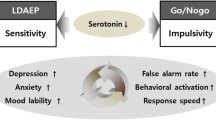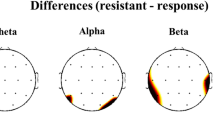Abstract
Rationale
The loudness dependence of the auditory evoked potential (LDAEP) has been proposed as a potential biological marker of central serotonergic activity. This study aimed to test the hypothesis that the LDAEP can be used to predict the response to escitalopram in patients with GAD.
Method
Twenty-five patients with GAD were recruited. Scores on the Hamilton Anxiety Rating Scale (HAM-A), Clinical Global Impression-Severity Scale (CGI-S), and Beck Anxiety Inventory (BAI) were evaluated. To evaluate the LDAEP, the auditory event-related potential was measured before beginning medication. Peak-to-peak N1/P2 amplitudes and current source densities were calculated at five stimulus intensities, and the LDAEP was calculated as the linear-regression slope. The current source densities of the evoked potentials were analyzed by standardized low-resolution brain electromagnetic tomography (sLORETA). The loudness dependence of the current densities (sLORETA-LDAEP) was also calculated.
Results
The pretreatment LDAEPs of all patients were positively correlated with the CGI-S response rates at 4 and 8 weeks, and with the HAM-A and BAI response rates at 8 weeks. The sLORETA-LDAEPs were positively correlated with the HAM-A response rates after 8 weeks of treatment. The HAM-A and CGI response rates at 8 weeks were higher in patients with a strong pretreatment LDAEP than in those with a weak LDAEP.
Conclusions
The present study revealed that GAD patients with a favorable response to escitalopram treatment are characterized by a stronger pretreatment LDAEP. Measurement of the LDAEP appears to provide useful clinical information for predicting treatment responses in patients with GAD.



Similar content being viewed by others
References
American Psychiatric Association (1994) Diagnostic and Statistical Manual of Mental Disorders, DSM-IV, 4th edn. American Psychiatric Press, Washington, DC
Bandelow B, Zohar J, Hollander E, Kasper S, Möller HJ, WFSBP task force on treatment guidelines for anxiety, obsessive-compulsive and post-traumatic stress disorders (2008) World Federation of Societies of Biological Psychiatry (WFSBP) guidelines for the pharmacological treatment of anxiety, obsessive-compulsive and post-traumatic stress disorders—first revision. World J Biol Psychiatry 9:248–312
Brett M, Johnsrude IS, Owen AM (2002) The problem of functional localization in the human brain. Nat Rev Neurosci 3:243–249
Connor KM, Davidson JR (1998) Generalized anxiety disorder: neurobiological and pharmacotherapeutic perspectives. Biol Psychiatry 44:1286–1294
Coric V, Stock EG, Pultz J, Marcus R, Sheehan DV (2009) Sheehan suicidality tracking scale (Sheehan-STS): preliminary results from a multicenter clinical trial in generalized anxiety disorder. Psychiatry (Edgmont) 6:26–31
Davidson JR (2009) First-line pharmacotherapy approaches for generalized anxiety disorder. J Clin Psychiatry 70:25–31
Fuchs M, Kastner J, Wagner M, Hawes S, Ebersole JS (2002) A standardized boundary element method volume conductor model. Clin Neurophysiol 113:702–712
Gallinat J, Bottlender R, Juckel G, Munke-Puchner A, Stotz G, Kuss HJ, Mavrogiorgou P, Hegerl U (2000) The loudness dependency of the auditory evoked N1/P2-component as a predictor of the acute SSRI response in depression. Psychopharmacology (Berl) 148:404–411
Garvey MJ, Noyes R Jr, Woodman C, Laukes C (1995) Relationship of generalized anxiety symptoms to urinary 5-hydroxyindoleacetic acid and vanillylmandelic acid. Psychiatry Res 57:1–5
Germine M, Goddard AW, Woods SW, Charney DS, Heninger GR (1992) Anger and anxiety responses to m-chlorophenylpiperazine in generalized anxiety disorder. Biol Psychiatry 32:457–461
Gorwood P (2004) Generalized anxiety disorder and major depressive disorder comorbidity: an example of genetic pleiotropy? Eur Psychiatry 19:27–33
Gudlowski Y, Ozgürdal S, Witthaus H, Gallinat J, Hauser M, Winter C, Uhl I, Heinz A, Juckel G (2009) Serotonergic dysfunction in the prodromal, first-episode and chronic course of schizophrenia as assessed by the loudness dependence of auditory evoked activity. Schizophr Res 109:141–147
Guille V, Croft RJ, O’Neill BV, Illic S, Phan KL, Nathan PJ (2008) An examination of acute changes in serotonergic neurotransmission using the loudness dependence measure of auditory cortex evoked activity: effects of citalopram, escitalopram and sertraline. Hum Psychopharmacol 23:231–241
Handley SL (1995) 5-HT pathways in anxiety and its treatment. Pharmacol Ther 66:103–148
Hegerl U, Juckel G (1993) Intensity dependence of auditory evoked potentials as an indicator of central serotonergic neurotransmission: a new hypothesis. Biol Psychiatry 33:173–187
Hegerl U, Gallinat J, Juckel G (2001) Event-related potentials. Do they reflect central serotonergic neurotransmission and do they predict clinical response to serotonin agonists? J Affect Disord 62:93–100
Hettema JM (2008) What is the genetic relationship between anxiety and depression? Am J Med Genet C Semin Med Genet 148C:140–146
Iny LJ, Pecknold J, Suranyi-Cadotte BE, Bernier B, Luthe L, Nair NP, Meaney MJ (1994) Studies of a neurochemical link between depression, anxiety, and stress from [3H]imipramine and [3H]paroxetine binding on human platelets. Biol Psychiatry 36:281–291
Juckel G, Molnár M, Hegerl U, Csépe V, Karmos G (1997) Auditory-evoked potentials as indicator of brain serotonergic activity—first evidence in behaving cats. Biol Psychiatry 41:1181–1195
Juckel G, Hegerl U, Molnár M, Csépe V, Karmos G (1999) Auditory evoked potentials reflect serotonergic neuronal activity—a study in behaving cats administered drugs acting on 5-HT1A autoreceptors in the dorsal raphe nucleus. Neuropsychopharmacology 21:710–716
Juckel G, Gallinat J, Riedel M, Sokullu S, Schulz C, Möller HJ, Müller N, Hegerl U (2003) Serotonergic dysfunction in schizophrenia assessed by the loudness dependence measure of primary auditory cortex evoked activity. Schizophr Res 64:115–124
Juckel G, Pogarell O, Augustin H, Mulert C, Müller-Siecheneder F, Frodl T, Mavrogiorgou P, Hegerl U (2007) Differential prediction of first clinical response to serotonergic and noradrenergic antidepressants using the loudness dependence of auditory evoked potentials in patients with major depressive disorder. J Clin Psychiatry 68:1206–1212
Juckel G, Hegerl U, Giegling I, Mavrogiorgou P, Wutzler A, Schuhmacher C, Uhl I, Brüne M, Mulert C, Pogarell O, Rujescu D (2008) Association of 5-HT1B receptor polymorphisms with the loudness dependence of auditory evoked potentials in a community-based sample of healthy volunteers. Am J Med Genet B Neuropsychiatr Genet 147B:454–458
Kendler KS, Gardner CO, Gatz M, Pedersen NL (2007) The sources of co-morbidity between major depression and generalized anxiety disorder in a Swedish national twin sample. Psychol Med 37:453–462
Linka T, Müller BW, Bender S, Sartory G (2004) The intensity dependence of the auditory evoked N1 component as a predictor of response to Citalopram treatment in patients with major depression. Neurosci Lett 367:375–378
Linka T, Sartory G, Bender S, Gastpar M, Müller BW (2007) The intensity dependence of auditory ERP components in unmedicated patients with major depression and healthy controls. An analysis of group differences. J Affect Disord 103:139–145
Manjarrez G, Hernandez E, Robles A, Hernandez J (2005) N1/P2 component of auditory evoked potential reflect changes of the brain serotonin biosynthesis in rats. Nutr Neurosci 8:213–218
Mulert C, Juckel G, Augustin H, Hegerl U (2002) Comparison between the analysis of the loudness dependency of the auditory N1/P2 component with LORETA and dipole source analysis in the prediction of treatment response to the selective serotonin reuptake inhibitor citalopram in major depression. Clin Neurophysiol 113:1566–1572
Nathan PJ, Segrave R, Phan KL, O’Neill B, Croft RJ (2006) Direct evidence that acutely enhancing serotonin with the selective serotonin reuptake inhibitor citalopram modulates the loudness dependence of the auditory evoked potential (LDAEP) marker of central serotonin function. Hum Psychopharmacol 21:47–52
Paige SR, Fitzpatrick DF, Kline JP, Balogh SE, Hendricks SE (1994) Event-related potential amplitude/intensity slopes predict response to antidepressants. Neuropsychobiology 30:197–201
Paige SR, Hendricks SE, Fitzpatrick DF, Balogh S, Burke WJ (1995) Amplitude/intensity functions of auditory event-related potentials predict responsiveness to bupropion in major depressive disorder. Psychopharmacol Bull 31:243–248
Park YM, Lee SH, Kim S, Bae SM (2010) The loudness dependence of the auditory evoked potential (LDAEP) in schizophrenia, bipolar disorder, major depressive disorder, anxiety disorder, and healthy controls. Prog Neuropsychopharmacol Biol Psychiatry 34:313–316
Pascual-Marqui RD (2002) Standardized low resolution brain electromagnetic tomography (sLORETA): technical details. Methods Find Exp Clin Pharmacol 24:5–12
Ramboz S, Oosting R, Amara DA, Kung HF, Blier P, Mendelsohn M, Mann JJ, Brunner D, Hen R (1998) Serotonin receptor 1A knockout: an animal model of anxiety-related disorder. Proc Natl Acad Sci USA 95:14476–14481
Semlitsch HV, Anderer P, Schuster P, Presslich O (1986) A solution for reliable and valid reduction of ocular artifacts, applied to the P300 ERP. Psychophysiology 23:695–703
Senkowski D, Linden M, Zubrägel D, Bär T, Gallinat J (2003) Evidence for disturbed cortical signal processing and altered serotonergic neurotransmission in generalized anxiety disorder. Biol Psychiatry 53:304–314
Sramek JJ, Tansman M, Suri A, Hornig-Rohan M, Amsterdam JD, Stahl SM, Weisler RH, Cutler NR (1996) Efficacy of buspirone in generalized anxiety disorder with coexisting mild depressive symptoms. J Clin Psychiatry 57:287–291
Strobel A, Debener S, Schmidt D, Hünnerkopf R, Lesch KP, Brocke B (2003) Allelic variation in serotonin transporter function associated with the intensity dependence of the auditory evoked potential. Am J Med Genet B Neuropsychiatr Genet 118B:41–47
Taylor DP, Eison MS, Riblet LA, Vandermaelen CP (1985) Pharmacological and clinical effects of buspirone. Pharmacol Biochem Behav 23:687–694
You JS, Hu SY, Chen B, Zhang HG (2005) Serotonin transporter and tryptophan hydroxylase gene polymorphisms in Chinese patients with generalized anxiety disorder. Psychiatr Genet 15:7–11
Acknowledgments
This study was supported by an unrestricted educational grant from H. Lundbeck A/S, who were neither responsible for creation of the study protocol, the data analysis, data interpretation, nor writing of the manuscript. The authors thank Eung-Kyung Jo and Jeong-In Kim for their assistance with data collection.
Author information
Authors and Affiliations
Corresponding author
Rights and permissions
About this article
Cite this article
Park, YM., Kim, DW., Kim, S. et al. The loudness dependence of the auditory evoked potential (LDAEP) as a predictor of the response to escitalopram in patients with generalized anxiety disorder. Psychopharmacology 213, 625–632 (2011). https://doi.org/10.1007/s00213-010-2061-y
Received:
Accepted:
Published:
Issue Date:
DOI: https://doi.org/10.1007/s00213-010-2061-y




